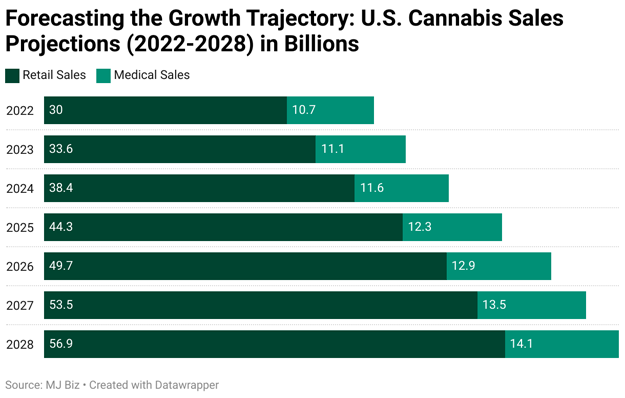
Bud, weed, marijuana, Mary Jane, ganja, blunt, pot, dope, herb…not too long ago, these words were as taboo as cocaine and other methamphetamines. Access to these products was achieved through the black market with no assurances of quality control, consistency, chemistry and safety. However, over the past three decades, states have begun to legalize the medical and recreational use of marijuana, budding into a $35 billion industry. This number is expected to balloon to $50 billion in 2026 (see chart below). As of January 2024, 40 states have legalized medical marijuana use, with a majority of those offering full legality for recreational use. Legalization of an industry typically follows with an expansive opportunity to reduce product costs and enhance margins for the businesses that serve it. We saw this economic effect after the cessation of alcohol prohibition in 1933. With the onset of the Great Depression, President Hoover saw the potential job growth and tax revenue that came with the legalization of alcohol. The results came swiftly, with $1.35 billion earned, almost half the federal government’s total revenue, in 1934 derived from alcohol and other excise taxes.

With this historic reference and so much momentum, one would expect ample opportunity to capitalize on participating in this space. How then, is it possible that so many businesses active in cannabis struggle to survive or thrive? MedMen,(MMNFF) a publicly traded retail distributor with over $130 million in sales, filed for bankruptcy on April 24th, 2024. This trend has seen a slew of other failures emerging from this space. To understand where the opportunities in cannabis lending lie, we must first dissect the causes of the failures that have hampered this industry.
I’ll start with the hurdles that are preventing the proliferation of this business.
Context and Considerations
• Licensing – Licensing requirements vary from state to state. It is important to note the various components and corresponding licenses related to this industry. For lending consideration, the simplified categories include:
- Cultivation (growing) – This is effectively the farming part of the business. The cannabis plant can be grown outdoors, but most often in a greenhouse, where the environment can be controlled. There are significant expenses related to the housing, and lighting to properly grow the cannabis plant.
- Distribution (retail and transport) – This includes moving the product between cultivation, manufacturing and retail premises. It can also include the rights to sell products through retail or distribution channels. This is generally done through a brick-and-mortar establishment and comes with a significant amount of red tape to qualify the facility to sell the products.
- Manufacturing – Cannabis includes a wide variety of products, including edibles, oils, raw flowers, dried products, topicals, etc. The type(s) of product(s) will determine the type of licensing, infrastructure and equipment that will be needed to produce the end product. We’ll discuss this in further detail below.
Licenses are very specific depending on the license type, the operation size, the geographic location and other limitations. The application process is rigorous and varies from jurisdiction to jurisdiction, but it can be a lengthy, costly process that can involve selection through a lottery process.
- Federal Classification and Regulations – Federally, cannabis is classified as a Schedule 1 substance under the Controlled Substances Act of 1970. This puts cannabis in the same category as methamphetamines, ecstasy, LSD and quaaludes. Even though a state can accept cannabis as a legal drug, it is still Federally illegal. This means that it cannot be traded across state lines and must be sold within the border of the state where it is produced. It also means that revenues from cannabis sales cannot benefit from standard business tax exemptions and are subject to taxation rates that correspond to illegal activities. As of May 2024, the DEA announced that they support the recommendation of moving cannabis from a Schedule 1 to a Schedule 3 substance. This would be a big win for cannabis, the effects of which are outlined in my lending considerations below.

- Banking – Given the Federal illegal categorization, federally chartered banks are unable and unwilling to lend or bank businesses related to cannabis, or in most cases, associated with cannabis products. This severely hampers the industry from obtaining capital to scale. These businesses are generally banked through credit unions and borrowing through private lenders that don’t have the same restrictions as banks. This creates some barriers for businesses and lenders to borrow from institutions but is an opportunity that we have found to be lucrative, given access to the right capital.
- State and Local Regulations – States impose different regulations on cannabis production to ensure safety, environmental protection, dosing, concentration and quality control guidelines. These include sample testing, x-ray analysis, myotoxin testing, pesticide testing, impurity testing, packaging and labeling requirements. California is notorious for being the most overarching in its regulations and requirements. When lending to this industry, it’s important to ensure that potential borrowers are compliant with regulations and have considered the time, material, and labor costs associated with compliance.
- Taxation – Currently, the taxes imposed on the purchase of cannabis products can exceed 40 percent. This figure is so high that it becomes restrictive to price affordably. So much so, that the illicit market for cannabis products continues to thrive and is hampering the growth and viability of the distribution channels. The income taxes imposed on cannabis-related businesses also impede profitability, as the tax rates are higher than most businesses, with no ability to take federal tax deductions for anything other than the Cost of Goods Sold. If the Schedule 3 change is met with final approval, this would mean cannabis would be treated the same as a standard drug covered by insurance, and cannabis medications can be prescribed in all 50 states, The taxation for the purchase and revenue would drastically decrease, both on the sales and income taxes. Ideally, this would open the door to a lot of opportunities.
Lending Considerations
Equipment
When underwriting a cannabis deal for an equipment finance transaction, we prefer the manufacturers, as they often purchase equipment with a stronger secondary market value. Generally, stronger assets are ubiquitous in multiple industries. The desired equipment relates to the extraction, testing, packaging, labeling and weighing of products. When we consider cultivation, we find greenhouses have less desirable equipment, including lighting, ventilation and housing equipment. These items have in-place value and don’t retain their value nor have as large a secondary market as farming equipment that can be used in traditional outdoor farming operations. The retail establishments tend to have the least valuable equipment to finance, as most of their equipment would be considered Furniture and Fixtures or FF&E.
Margins
When reviewing cash flows for the above classes of cannabis businesses, in addition to basic creditworthiness, we consider the classification of the business, the product margins, the market they serve and the likelihood of success. Although retail sales appear to have the biggest margins, retailers have faced the biggest challenges with limited customer retention, high fixed costs, overhead, staffing, product costs, security, compliance and taxes. Consequently, they tend to have the slimmest net margins of the three sectors of the industry. The manufacturing facilities that have seen the most success tend to have a branding component and automation to reduce costs and retain consumer loyalty. This is an area where we have found much success in financing equipment that gives manufacturers the edge. Cultivation facilities, similar to farms, face a lot of uncertainty and are very reliant on the yield and quality of their products. We have found that the successful operators have some experience in agriculture and staff experts to maintain quality control and product consistency. The growers also tend to have the lowest tax rates, as they are still granted many agriculture exemptions to aid in their margins.
Overall, the industry is still very young and continues to be dynamic. These oscillations continue to trend in the right direction offering traction for lending opportunities. With opposing policymakers rising from changing administrations, there remains uncertainty concerning how regulations, taxation and legalities of the industry will change; however, it appears that the industry is here to stay eradicating the fears and suspicions of drastic changes that would halt the industry altogether. In fact, it appears that banks will likely enter the space and offer direct financing options, as well as a broad array of capital products to bolster the equipment finance industry that serves the broader cannabis sector.
Editor's Note: This article was originally published in the May/June 2024 issue of NEFA Newsline, the official magazine of the National Equipment Finance Association.